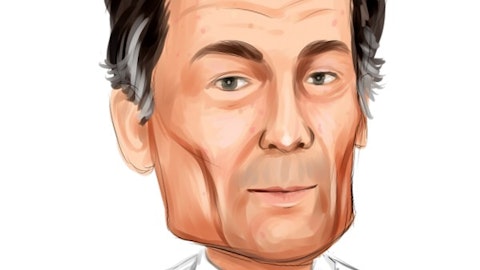It’s no longer 100 basis points, a 100 basis points, 100 basis points, but it’s about a third of that remaining gap that’s out there. The, other big piece that’s still out there now is really this roll on, roll off of some of these contracts that we have in our network and we’ve said, a lot of those start to roll off in earnest in the back half of ’25 and ’26 and we really hit full run rate on that in kind of the ’26 timeframe when those roll off and that’s the other, I’d say big chunk and then whatever remains is the business performance piece of it to make up that gap.
Operator: Thank you. Our next question comes from John Murphy with Bank of America. You may ask your question.
John Murphy: Good morning, guys, and congratulations to all of you on sort of a hard fought next steps in your lives and careers. It’s impressive. Just a first question on cash conversion, Jerome, the numbers, obviously, to finish the year were very strong given the focus on cash conservation. The number for ’24 looks pretty good. I’m just curious, is there any kind of swing factor to the negative in ’24 because there was such a strong performance at the end of ’23 and how do you think about, cash conversion over the mid to long term in the business?
Jerome Dorlack: In terms of a swing factor, I think there’s a couple of things. One is if you look at CapEx as an example, CapEx we ended ’23 at call it a $260 million run rate and we’ll go into ’24 at kind of $310 million level. There was a lot of these cash conservation activities that we had in the business really driven by Doug and the team. As we knew with the UAW strike, we really had to kind of batten down the hatches and get aggressive from a cash conversion standpoint. So there’s that, that element of normalization. We also had from a couple of customers actually just ARAP timing. Nothing we did, they actually timed it out a bit differently. So there is a swing in there that occurred. We won’t necessarily quantify it, but there is a level of swing. So when you think about long term cash conversion, I’d look at that number that we have in ’24, kind of the $300 million on $985 million is the long term cash conversion rate for the business going forward.
Doug Del Grosso: I don’t know, Mark, if there’s anything you want to add.
Mark Oswald: The only other thing I’d say, John, when I think about longer term cash conversion, right, our calls for cash going forward are pretty stable, right? So if you just think about what the drivers for cash is going to be, it’s going to be EBITDA growth, right because I know what my interest is going to be. I know my restructuring is down to a normalized level. My cash taxes, right, thanks to our, plumbing that we’ve set up is very favorable. So really with the calls for cash stabilized, I’d really look at EBITDA growth and use that as a proxy for where you see pre-cash flow going forward.
John Murphy: Okay, that’s very helpful. And then just a second question. You guys snuck this in in one of your slides that, in China you’re going to swing. you have a leading position in China already, but from 40% Chinese domestic, mix in China to 60%, but you didn’t give a timeframe on when that was going to happen. I was wondering if you can maybe talk to that and then also if you’ve got a handle on, at this point and where this will go over time, the sort of the mix of your vehicles that stay in country versus those that get exported, because obviously it’s, China swung to a major export hub in a way over the last two years. So as you’re increasing that mix to the Chinese domestics, that might be helpful in market, but might even be more helpful on the export basis. I don’t know if you can give us some color on that.
Doug Del Grosso: So, first of all, appreciate your comments on the leadership transition. With regard to that mix of customer change, we’re anticipating that’s going to happen over, definitely in our five-year planning period, probably along, the three-year timeline and we’re fairly confident in that because when you look three years out, the bookings are, if not done are, clearly visible. and we view that with high level of confidence. With regard to the amount of vehicles China is exporting right now, as you know, those are lower level vehicles and have not necessarily been on our radar. Our focus certainly has been on the Chinese domestics, certainly the ones that are growing or outgrowing the market. We’re still focused on the luxury segment and still paying attention to our traditional customer base, though we clearly see the mix changing.
I don’t think it’s crystal clear what’s going to play out over the course of the next five years. Certainly there’s indications that Europe’s going to put up some level of resistance that’s probably going to drive domestic Chinese and they’ve already signalled that to reshore in the European market in Eastern Europe, but, if it continues to be an export market and those vehicles shift into the higher end vehicles, we think we’re well positioned there. If they move and reshore into the European market, we think our infrastructure capability there in Europe, particularly in Eastern Europe, puts us in a pretty good position. So we’re pretty confident the way that is going to play out but, as you know, it’s like I say, it’s not crystal clear how that’s all going to come together.
But we do understand, the competitive advantages that the Chinese have, and that’s a compelling case for them to continue to grow market share.
Operator: Thank you. Our next question comes from Emmanuel Rosner with Deutsche Bank, You may ask your question.
Emmanuel Rosner: Thank you very much. So I appreciate your assessment of the shift in industry dynamics that is now taking place and I wanted to hone in a little bit on electric vehicles in particular. So as you mentioned in the slides and in the prepared remarks, there’s a little bit of a push out of some of these launches or reduction of some of the near-term EV volumes, especially in North America. Can you comment to what extent, if any, this is impacting your business? This is impacting your backlog? Does it have an impact on your growth of a market in the near term? And specifically, and maybe second part of this question, when I look at the growth of a market, guided for 2024, which seems to be about a point, maybe a little bit below average, when it seems like you were heading in an above average type of direction, I’m wondering if EV push out is a factor within that.



